“Beef Welling-Ton!” exclaimed Sebastián Zuccardi with delight when presented with Kerridge’s finest fillet wrapped in spinach, mushroom mousse, and crispy suet pastry.“This is a craze now in Argentina.” His unguarded happiness lit up the room.

Kerridge's Beef Wellington
There had also been a distinct waft of awe in the room as ten of us sat in hushed devotion. I'm not sure Zuccardi even noticed. He appeared immune to adulation.
Argentina: an old-world wine producer in a new-world country
Thanks to a population that loves to eat and drink its own produce, Argentina has a flourishing, long-established, sophisticated, ever-evolving wine scene that is well able to stimulate all tastes. Despite nationwide fiscal chaos, you will find the bars and restaurants are full. Argentinians are the living embodiment of the proverb, ‘There are no pockets in shrouds’. And so might you be if the price of your daily flat white doubled in the time it took you to drink it.
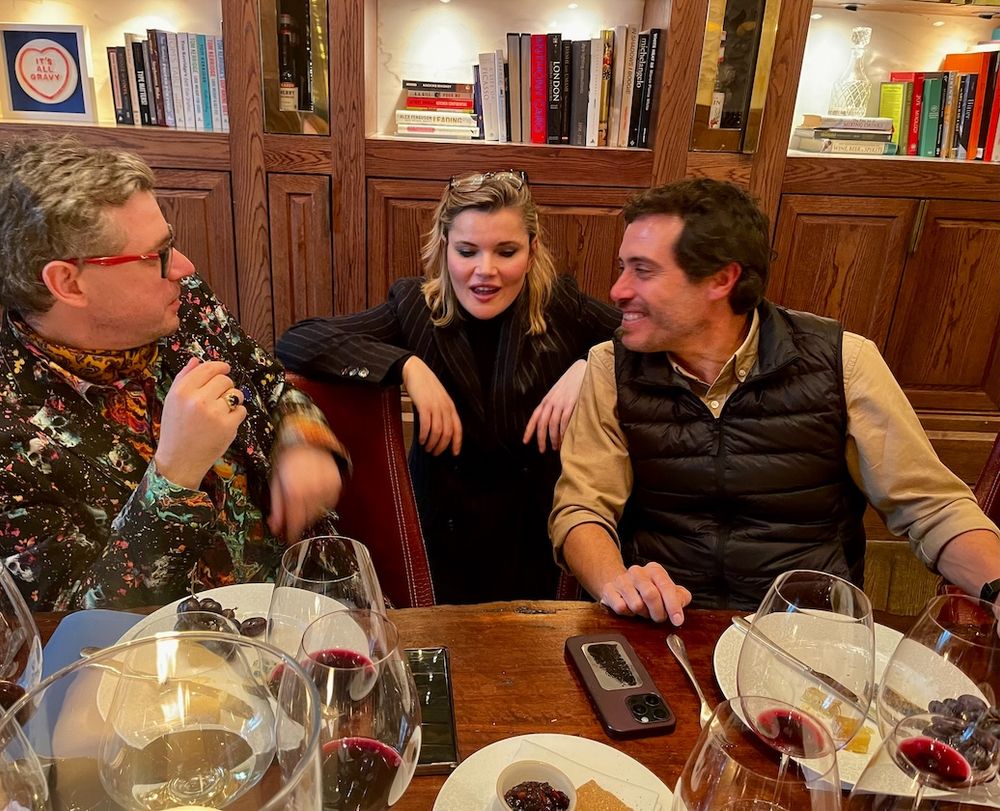
Sebastián Zuccardi (r) at lunch with Lisse Garnett
The Zuccardi family story is Argentina’s in miniature. The family emigrated from Italy in the 19th century, from Avellino, no less. Those of you who are Soprano’s superfans will recognise that name, for it is the very place from which Tony Soprano hailed. This is, I think, significant – like most of the Italian immigrants in Argentina, the Zuccardi clan came from the poor agrarian south, in Campania, 29 miles east of Naples, a place where people learned to survive by sticking together.
Perhaps that’s why Argentinian producers collaborate so successfully. As Zuccardi took us through the seven wines he’d brought for us to taste, we spoke of the Michelini family, Eduardo Soler of Ver Sacrum, and Juanfa Suarez of Finca Suarez, his winemaking mates, who are just as passionate about Argentina’s radical terroir as he is.
What is so magnificent about Zuccardi is that despite his obvious, some might say, precocious talent, he is not given to hyperbole. For him, wine is about “the place, the people, and the year it was made.” He worked in France, Spain, Portugal and the US to hone his skills and believes in drinking wines he hasn’t made.
It is a mistake to see wine in Argentina as ‘new’. As Zuccardi appositely put it, “Argentina is an old-world wine producer in a new-world country.” Unlike other New World countries that have fashioned their wine production predominantly for export, Argentina has always made creative wines for its diverse population of predominantly European immigrants.
Buenos Aires feels like old Europe on steroids. The humble rubber plant, once a Victorian drawing room staple, grows a broad trunk and can reach over a hundred feet in Argentina, and many of them do.
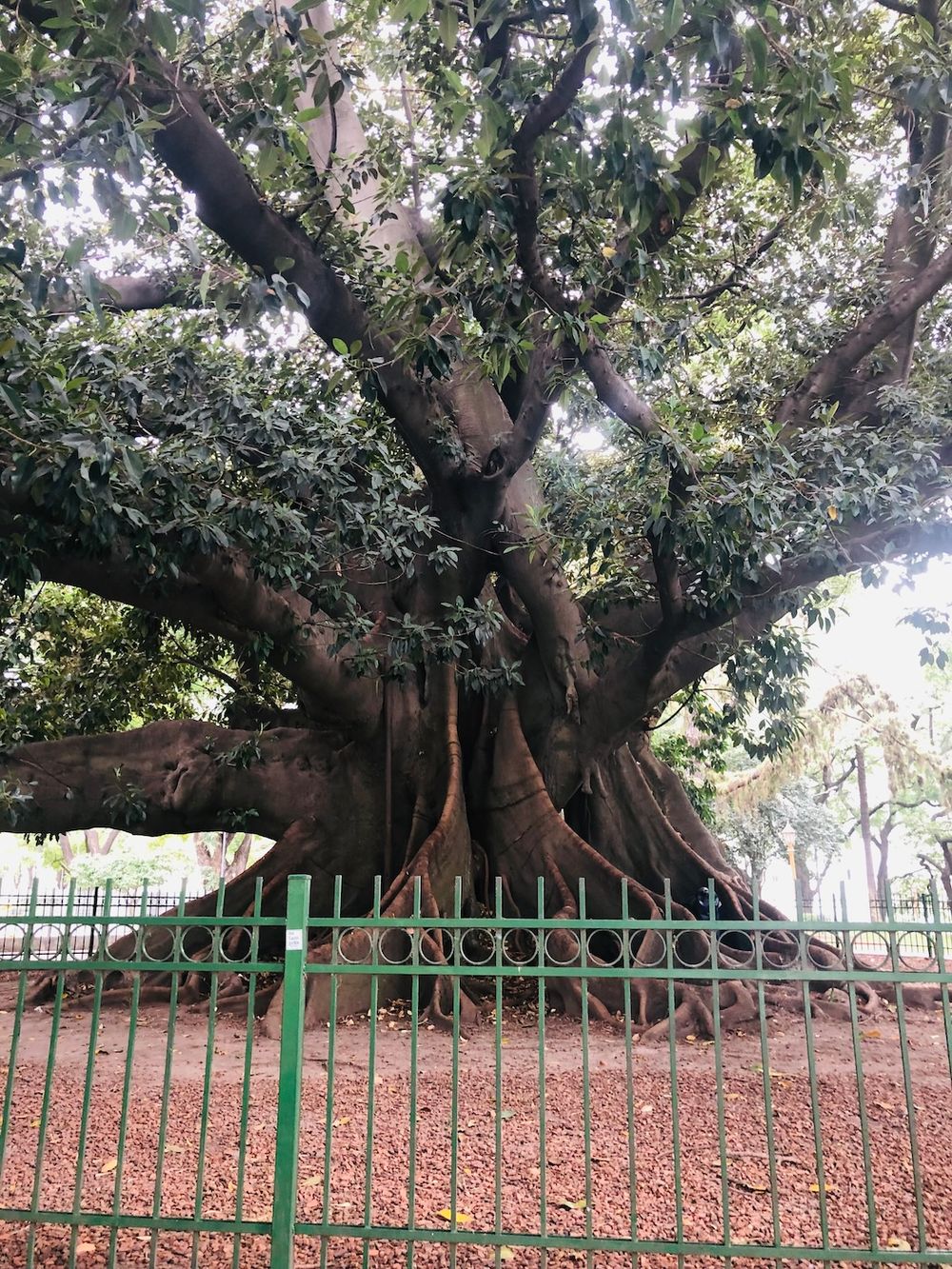
"It's a rubber plant Jim. But not as we know it"
Elegant Haussmann-esque lateral apartments and generous vistas reflect the boom years at the dawn of the 20th century when Argentina was one of the ten richest countries in the world. Even the grapes are early European imports that have flourished in their new surroundings.
Pre-phylloxera Malbec, spawned by massal selection, is Argentina’s premium category calling card. There is a whole deck of other varieties to explore, too but Zuccardi sees Malbec as “the most transparent grape when it comes to expressing terroir.”
Argentinians consume approximately 75% of the wine they produce (Zuccardi exports 50% of his wines) and, until the 1980s, the dominant category was white. A well-publicised and oft-criticised influx of international consultants keen to produce lucrative, heavily oaked reds put paid to much of the white wine production, although today the category is gaining ground again.
Pre-80s whites, or more accurately pinks, were predominantly made from Criolla, a cross between Listán Prieto aka Mission and Muscatel de Alexandria, from which have now manifested 60-plus crosses currently being researched and labelled by INTA.
A winery of the people
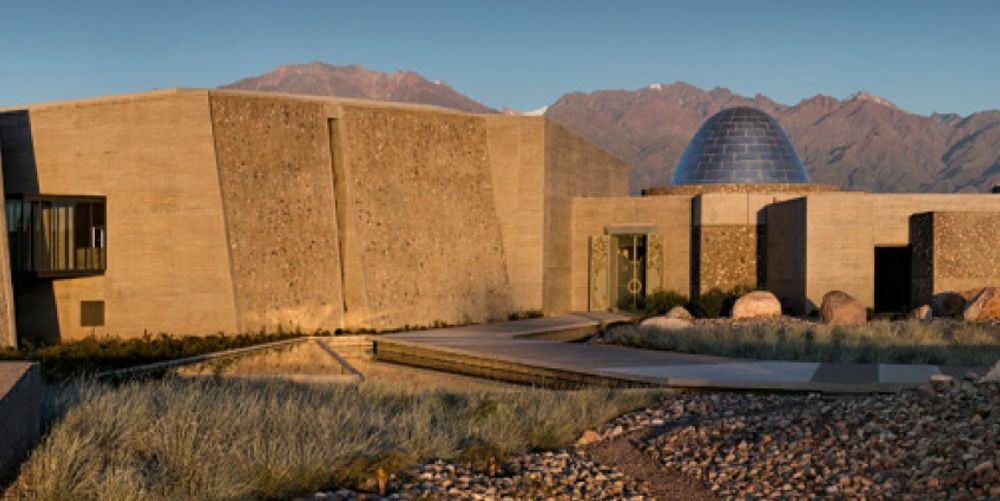
Zuccardi winery: a regular award winner for its sustainable design
Wine for the Zuccardi family began in 1963 when Sebastián’s grandfather planted vines. Argentina is a desert, great for controlling disease but not so great for water. Sebastián’s grandfather invented and patented an irrigation system. He bought land to show what his system could do and promptly fell in love with growing grapes. Jose, Sebastián’s father, devoted himself to wine.
Phil Crozier was the first to bring Zuccardi Wines into the UK when running Gaucho and his association goes way back. I asked him for the lowdown on brand Zuccardi.
“Zuccardi has been the standard bearer for Argentina ever since it entered the UK market. Sebastián’s father José, started it, and now the baton has been passed onto Sebastián. José remains a great ambassador for Argentina.”
“I think Zuccardi is a winery of the people. It really is a family business with restaurants, wine, and now olive oil. Sebastián describes himself as a farmer and it's true they are not posh. There is real humility. They are a very humble family, and they are very generous when talking about the country as a whole.”
“They talk to sommeliers, but they are consumer-led. I remember meeting José in London once, and they were off up to York, and I said what are you doing in York? He says ‘Oh, we are hosting the annual bellringers York Minster Society dinner.’ They like to talk to their consumer, and people never forget that. You always see them when you are in one of their restaurants too, chatting to people eating there.”
Selling fine Malbec to the world
The Uco Valley in Mendoza has had plantings for over a hundred years; talented winemaker and former rockstar Juanfa Suarez of Finca Suarez (next door to Zuccardi in Paraje Altamira) showed me a book that his grandfather Leopoldo Suárez wrote about propagating Semillon in this calcareous rocky ground back in 1911. But it was Catena in 1994 who saw the possibilities of altitude. Sebastián Zuccardi planted his first high altitude Uco vineyard in 2004, having bought Uco grapes since early 2000. Today, Zuccardi has ten different vineyards at altitude in the Uco Valley.

Granite encased in limestone that Zuccardi had to clear from his vineyard, the stone latterly being used to build the new winery
Zuccardi’s Uco wines reflect the terroir from which they come; we tasted wines from three villages: Altamira, San Pablo and Gualtallary, each on an alluvial fan of mixed materials (formed by ancient rivers). They are ‘mountain wines’ grown on alluvial soil raised up by the titanic crash of two tectonic plates.
At 5000m, you’ll find fossils of calcareous sea creatures and granite cased in calcareous limestone. Some of the rocks are huge, yet you feel sand beneath your toes. The wines are achingly modern, lean, and terroir-driven; they speak of chalk, altitude, blood, texture, and searing freshness.
Mendoza is a dry desert situated inbetween the mountains and the Pacific Ocean so disease pressure is very low; it is cold and surprisingly continental in climate. Vines are grafted to avoid issues with nematodes. The region is famed for its intense sunlight, which facilitates aromatics and ripens tannins. A huge diurnal range retains acidity and freshness; the average temperature is low, and varied altitude provides for nuanced climatic variation. Irrigation is possible thanks to the Andes meltwater. All in all, it's pretty perfect for growing vines, though snow volume is increasingly threatened by global warming.
Zuccardi has vineyards in Monasterio, Gualtallary, where Argentina’s oldest winery, Benegas is and where Chandon planted back in 1992. Adriana (Catena) and Per Se (Edy del Polpolo) are there, too. You might say it’s the Grand Cru of Gualtallary. San Pablo is another favoured spot, as is Vista Flores. All these Uco regions have a different identity in the glass; the valley is as nuanced as Burgundy. Sebastian favours the place over the grape on labels to reflect this.
Zuccardi was not the first wine producer to go to the Uco Valley, but it was the first to separate Uco from the rest of its business with Zuccardi Valle de Uco – a clear, terroir-driven statement of intent. Brilliant marketeers, it has sold Mendoza and fine Malbec to the world.
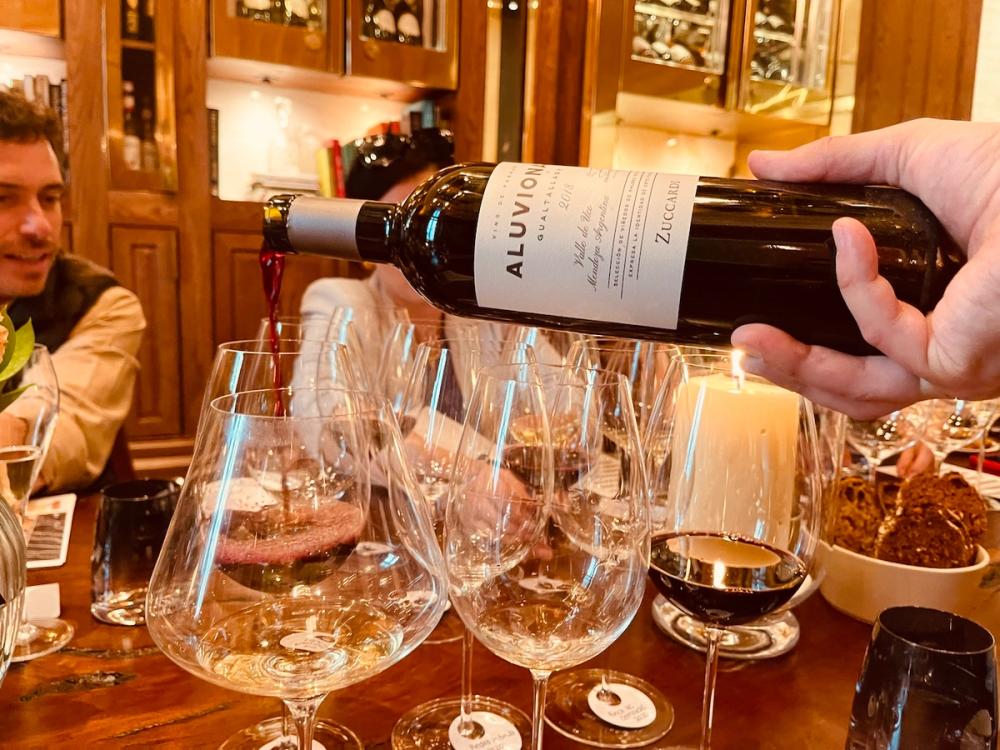
Lunch with Zuccardi, London, 2024
What's next for Sebastián?
Expressive Malbec is not an entry-level wine that you can knock up for a low price, and he thinks it’s time to get evangelical about Argentina’s other grapes and sell them to the world. For some time, he has been making wonderful Criolla wines under the Cara Sur label, wines that are comparatively inexpensive. He is also a huge advocate for Semillon and Torrontés.
There is a whole new wave of Argentine producers making delicious quaffable, often complex sup that has never reached our shores. Cue Crozier (Gaucho and WOFA) and Laurie Webster (formerly of Las Bodegas), who are making it their mission to change this narrative. They import Cara Sur through their company Ucopia Wines and are bringing in a range of other Criollas, Bonardas and more besides. They are what you might call ‘Argentina-obsessed’.
For Sebastian Zuccardi, wine is about place. He says first, you must put the place on the map, and then you talk about the grapes. The ability to adapt, survive, innovate, and thrive is what Argentina, Uco and Zuccardi are all about. By sticking together and talking about place, Argentine producers have built nuanced regional identities. Their challenge for tomorrow is to reveal their talent for everything else but Malbec to the world.
So how were the wines tasting?
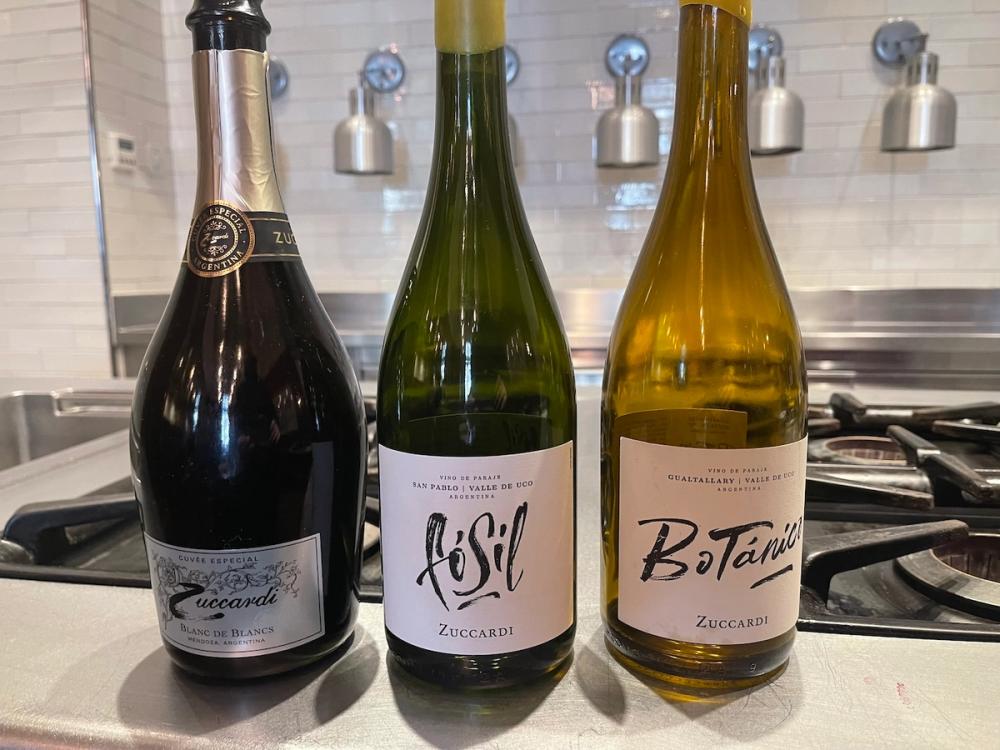
Zuccardi Cuvée Especial Blanc de Blancs 2017 12.5%
100% Chardonnay. Salty yellow apple, peach, pear, citrus, dough, white pepper and honeyed brioche, arrow sharp, incisive.
Zuccardi Fósil San Pablo Chardonnay 2021 13%
Grown in San Pablo, one of the coldest areas 300m from the mountain, (3°C degrees colder than Gualtallary, this year they lost 70% of the harvest to frost). It’s the last plot Zuccardi harvests; he says the Chardonnay here exceeds his skills – it is the place that creates great white wine. Soils are mixed granite and limestone. 80-90% concrete, 10-20% in old 500l barrels; he favours concrete for Chardonnay as he doesn’t want to ‘open the wine’ with oxygen. No malolactic. Indigenous yeast and ferment is not cooled; he finds a warm ferment expresses the place rather than the ferment. Racking is done or not done depending upon the taste.
This smells of the local Mendozan harvest herb chinchilla, aka Huacatay. Bright, sharp and linear. Laced with thyme, lime, mint, citrus, tarragon, and basil, it is chalky and textural. First, it resists before morphing into salted caramel and pineapple-tinged ecstasy. Extraordinarily electric, superlatively precise.
Zuccardi Botànico Gualtallary Chardonnay 2021 13%
Grown in Gualtallary, Monasterio, Mendoza’s grand cru, where the soil is known as ‘caliche’ – a distinctive compaction of granite and calcareous limestone at 1380m. 80-90% concrete, 10-20% in old 500l barrels; since 2016 when they first harvested they have used less and less oak. No malolactic. Indigenous yeast, ferment is not cooled. Racking is done or not done depending on the taste. This is the first to be harvested in Uco, thanks to its distance from the mountain.
As with the Fósil, this morphs in the glass. It begins savoury and austere, tinged with salty tension; lemon, garrigue-scented, mineralic, clean and pure, but given time, I find warm toast notes, a bat squeak of lime; the texture is chalky yet silky, salty and viscous, creamy almost. This is what the word elegant was coined for.
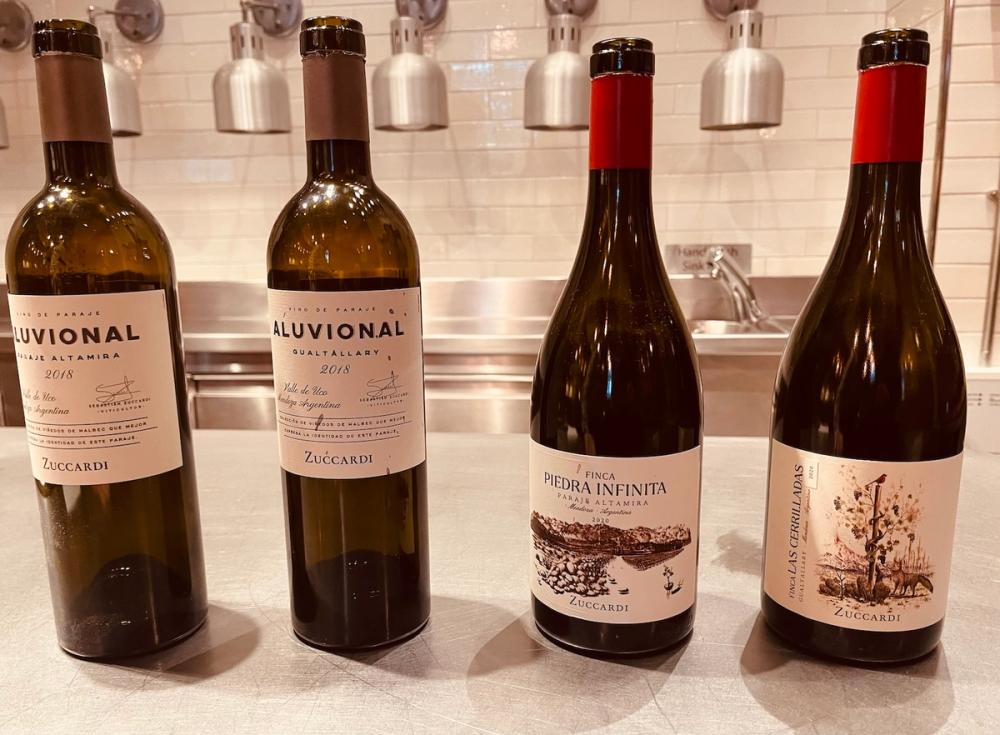
Zuccardi Aluvional Altamira Malbec 2018 14.5%
Zuccardi favours Malbec grown via massal selection in his own nurseries (Edy del Popolo and David Bonomi buy from Zuccardi) from what he describes as “pre-phylloxeric”; vines that entered Argentina before phylloxera struck Europe.
The fruit comes from alluvial Altamira on very stony granite/limestone soils (see picture) at 1100m. No oak, the wine is fermented and aged in concrete, 80% whole bunch, no carbonic to give a more pronounced sense of place.
Fine, tensile and savoury; stimulating, stony and structured with black olives, liquorice, black pepper, herbs and cherries. Effortlessly elegant.
Zuccardi Aluvional Gualtallary Malbec 2018 14.5%
The fruit comes from alluvial Gualtallary from grapes grown on ‘caliche’ soil. 30-50% whole bunch, no carbonic to give a more pronounced sense of place. The wine is fermented and aged in concrete to avoid imparting flavour, maintain temperature, and allow less micro-oxygenation than a small barrel.
Energetic, wild and intense yet restrained. Savoury, salted liquorice, iron, blood, black pepper, violet and salted plum. Complex, textured, deeply stimulating, stony and yes, mineralic (sorry).
Zuccardi Finca Piedra Infinita 2020 14%
This single-vineyard wine hails from Altamira, located at 1100m south of the Uco Valley. The clue to the soil is in the name; it took one thousand trucks to remove the stone from this vineyard, the stone that was used to construct the winery six years later. The vineyard sits on an alluvial fan and is divided into 60 soil parcels. They had to build a winery to accommodate the myriad parcels that were blended to create this wine.
Fermented in concrete, 80-100% whole bunch. Precise, elegant, muscular, and sinewy; it is eel-like and bright. Eventually, it acquiesces in the glass, bringing salted Asian plum, sour cherry, tar, violets, garrigue, blood, black olive and moreish tannins as fine as baby powder.
Zuccardi Finca las Cerrilladas 2020 14.5%
This single vineyard of 19 hectares, divided into 30 parcels, purposefully surrounded by 13 hectares of natural vegetation wine is from a site in Gualtallary Monasterio in the north of the Uco Valley at 1400m, anecdotally known as the Grand Cru of Mendoza with old calcareous soils protected by mountains. Fermented in concrete, 30-50% whole bunch.
Black olive, iodine, salted Asian plum, and graphite; herbaceous, savoury, and damson-hued; it’s oh so delicately fruity, mineralic, and silky with a tar-tinged chalky grip. Linear and ethereal yet still tangibly precise and firm. Effortlessly elegant (again).
The wines of Zuccardi are imported and sold in the UK by Hatch Mansfield which is a commercial partner of The Buyer. To discover more about them click here.
































